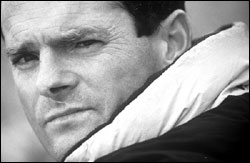Speaking by phone recently from New York, Joe Simpson discussed how the readership of Touching the Void has evolved over the years. Today, he notes, “it’s quite clear that 90 percent of the people who read it are not climbersthere’s a twin audience.” Most people “either get a vicarious thrill reading it, or, more significantly, the story has gone outside of its genreit’s really no longer about mountaineering. Because it deals with very big questions that I didn’t realize at the time: trauma, fear, betrayal, trust, friendship . . . and death, of course.”
Today, roughly a million copies of Void are in printincluding a February paperback (Perennial, $12.95), in which Simpson adds a new chapter on the making of the film. How does that broad interest differ from the old small canon of mountaineering literature, including Maurice Herzog’s Annapurna, that inspired Simpson during his youth?
“I think [those books] also deal with something greater,” answers Simpson. “Many non-climbers think climbing is about high-altitude willy waving and muscling your way up peaks. [Climbing literature] says a lot more about the philosophies and the psychology that the sport evokes in people. You see human qualities that you perhaps don’t see when you read about a golfer’s life or a footballer’s life.”
Where he used to give slide shows to climbing clubs, Simpson adds, “Now I do these corporate motivational talks. I don’t bang on about messages. Other people appropriate the story for themselves. They might look on it like a car smash and think, ‘Good Godwhat would I do in that situation?’ The irony being that [for Simon Yates and him] it was our car smash, it was our reality.”
Reality took a different twist, however, when Simpson accompanied the film crew back to Peru and the site of his accident. “It’s something I’m quite pissed off about. They wanted me to do all the reconstructions on the glacier and on the rock, because it was cheaper than paying an actor. When you see some of those really long pullback shots, and you see a tiny figure in the rocks, and you get the whole scale of itwell, that’s me! It was very disturbing. My memories came back as if it was yesterday.” (This footage subsequently wasn’t used.)
Yet Simpson feels the finished film is faithful to his book, without making his experiences seem typical of climbing. “Maybe, just maybe, if people do go and see this in the cinema, they might think, ‘Well, actually, mountaineers aren’t like in Vertical Limit.’ Or . . . they might think that Touching the Void is standard mountaineering fare, which it isn’tthank God.” B.R.M.




